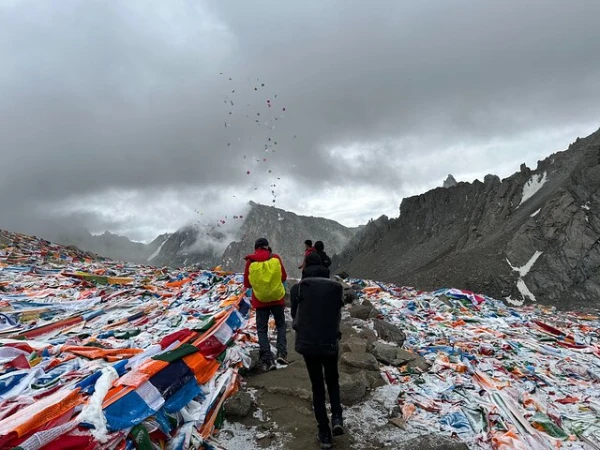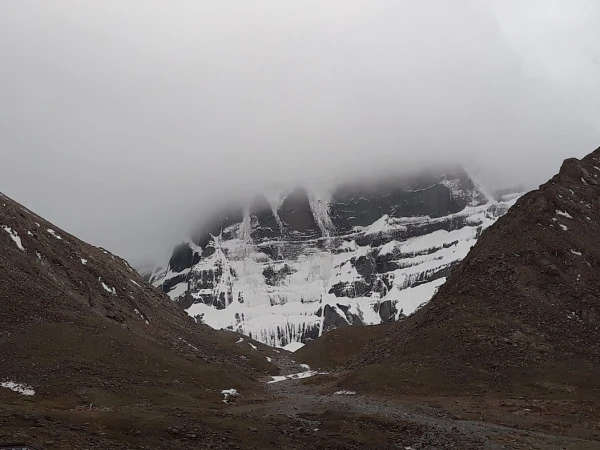Pèlerinage du Kailash Mansarovar – Une Expérience Spirituelle Unique
Le Kailash Mansarovar Yatra est l’un des pèlerinages les plus sacrés au monde, attirant chaque année des milliers de dévots de différentes confessions. Le Mont Kailash, culminant à 6 638 mètres au Tibet, est considéré comme la manifestation terrestre du Mont Meru, le centre spirituel de l’univers.
Pour les hindous, Kailash est la demeure du Seigneur Shiva.
Pour les bouddhistes, c’est un mandala sacré représentant l’illumination.
Pour les jaïns et les adeptes de la religion Bon, le mont revêt également une importance spirituelle majeure.
Les pèlerins visitent également le Lac Mansarovar, un lac sacré aux eaux cristallines, censé avoir été créé par le Seigneur Brahma, réputé pour ses vertus de purification spirituelle et physique.
Itinéraire recommandé : Route via Kerung, Népal
La route la plus populaire et accessible pour les pèlerins népalais et indiens est celle passant par Kerung, Népal. L’itinéraire débute à Katmandou, puis se poursuit par la route à travers Syabrubesi jusqu’à la frontière tibétaine. Après avoir traversé la frontière, les pèlerins se rendent à Kerung, puis à Saga, avant d’atteindre enfin le Lac Mansarovar et le Mont Kailash.
La route de Kerung est particulièrement avantageuse car elle permet un gain d’altitude progressif, réduisant les risques liés au mal aigu des montagnes par rapport aux itinéraires plus rapides et plus exigeants.
Meilleure période pour le pèlerinage
Le meilleur moment pour entreprendre le Kailash Mansarovar Yatra se situe entre mai et septembre :
Mai à juin : températures modérées et paysages verdoyants.
Juillet à août : la mousson peut affecter le Népal, mais le Tibet reste relativement sec.
Septembre à début octobre : conditions idéales avec ciel dégagé et visibilité parfaite des sommets himalayens.
À éviter : l’hiver (novembre à avril), en raison des fortes chutes de neige et de la fermeture des cols.
Permis et documents requis
Voyager au Tibet pour ce pèlerinage nécessite plusieurs documents officiels :
Visa de groupe pour le Tibet (obtenu auprès de l’ambassade de Chine à Katmandou)
Permis de voyage pour le Tibet
Permis spécial pour étrangers (Alien Travel Permit – ATP)
Forme physique et altitude
Bien que le pèlerinage ne nécessite pas l’ascension directe du Mont Kailash, il comprend la Parikrama (circumambulation) de 38 km autour du mont, avec un point culminant au col Dolma La (5 630 m).
La marche à haute altitude est physiquement exigeante, et il est recommandé aux pèlerins d’être en bonne santé générale.
Consultation médicale préalable fortement conseillée pour les personnes souffrant de problèmes cardiaques, respiratoires ou de tension.
Acclimatation : des jours d’acclimatation sont prévus, avec possibilité d’oxygène supplémentaire si nécessaire.
Santé et sécurité
La préparation médicale est essentielle pour ce pèlerinage à haute altitude.
Apporter des médicaments prescrits et éventuellement des comprimés pour le mal aigu des montagnes (Diamox).
Les organisateurs fournissent des kits de premiers secours et de l’oxygène d’urgence.
Il est fortement recommandé de souscrire à une assurance voyage incluant l’évacuation en haute altitude.
Équipements et affaires à emporter
Les vêtements et équipements doivent être adaptés aux conditions froides et venteuses des hautes altitudes :
Sous-vêtements thermiques et vêtements chauds superposables
Veste en duvet et coupe-vent
Chaussures de trekking robustes, chaussettes en laine, gants et bonnet
Lunettes de soleil, crème solaire SPF 50+, baume à lèvres
Lampe frontale ou torche, gourde réutilisable et encas
Articles de toilette, papier toilette et lingettes humides
Médicaments personnels et trousse de premiers secours
La plupart des opérateurs fournissent un sac de voyage et une veste en duvet réutilisable.
Hébergement et repas
À Katmandou : hôtels 3 étoiles confortables pour préparation et repos.
Au Tibet : logements basiques dans des guesthouses et lodges, avec installations limitées.
Repas : végétariens, comprenant dal-bhat, soupe de nouilles, roti-sabzi, fruits. Eau chaude disponible, mais il est conseillé de prévoir sa propre bouteille et pastilles de purification.
Transport
Le trajet se fait entièrement par route, avec véhicules privés tels que jeeps ou bus touristiques.
Routes parfois accidentées mais offrant des paysages himalayens à couper le souffle.
Aucun vol n’est nécessaire pour le trajet via Kerung.
Importance spirituelle
Le Kailash Mansarovar Yatra est plus qu’un simple trek : c’est une expérience spirituelle profonde.
La Parikrama complète du Mont Kailash est considérée comme capable d’effacer les péchés accumulés sur plusieurs vies.
Un bain dans le Lac Mansarovar équivaut à des centaines de bains sacrés ailleurs.
Récitation de mantras, prières et méditations enrichissent l’expérience spirituelle.
Chaque étape du voyage est imprégnée de sérénité, dévotion et contemplation, offrant aux pèlerins une opportunité unique de purification et élévation spirituelle.





.webp)

